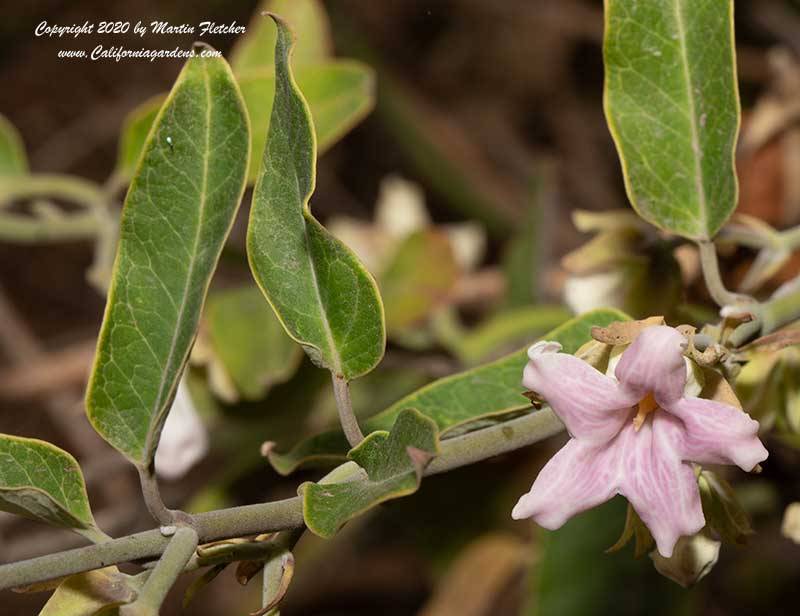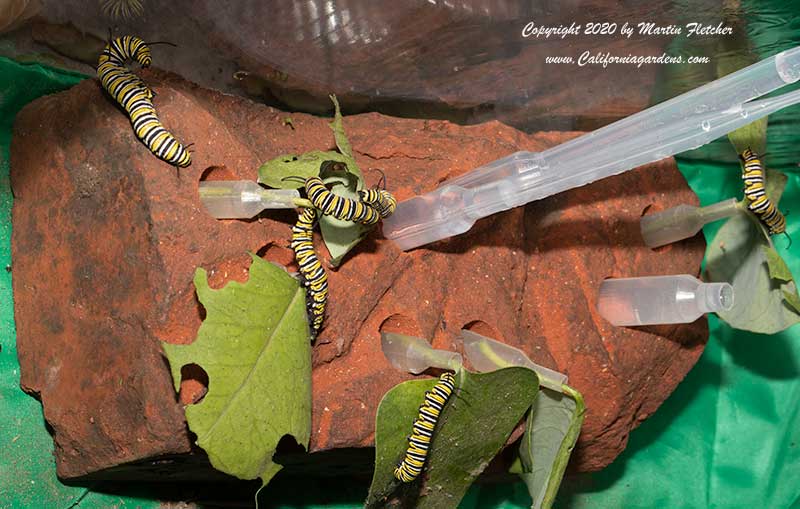Araujia sericifera * Bladder Vine
Araujia sericifera is a vine in the Milkweed Family, Asclepidacea. This family has been combined with the Apocynacea, the Dogbane Family. Araujia sericifera is native to South America. The Bladder Vine grows in full sun to complete shade. Once established the plants will need little or no water. Fragrant Creamy White to Pink flowers are moth pollinated from late Spring through to Fall. This plant can be a pest but it has some redeeming aspects. It turns out the Monarch Butterfly Caterpillars love to eat the leaves. This has proven quite useful. As to the cautionary side, the Bladder Vine is easily germinated from seed that floats away on a breeze. Araujia sericifera blooms for a long period of time, meaning there will be nearby seedlings for much of the season. Araujia sericifera likes to climb things, anything up to the tops of the trees or nearby fences and shrubs. They will wrap and even strangle trees and shrubs. But hey the monarchs eat them so they have come a ways back to being on my good plant list. Another bit of good news for the Monarch's the protazoan that is dangerous for them with the tropical milkweeds is not a problem due to the tenderness to even a mild frost. The tops will die back with any significant frost but these milkweed plants are potentially root hardy into the teens

Flowers and foliage of Araujia sericifera the Bladder Vine. High resolution photos are part of our garden image collection.

A feeding brick for the Monarch Butterfly Caterpillars, they are feeding on Bladder Vine, Araujia sercifera. The Milkweed related Bladder Vine is acceptable food for the Caterpillars, though the Monarch Butterflies will not lay their eggs on this plant. They were slow to think that this would be OK until the Narrow Leaf Milkweed plant started to get pretty bare. Then at every instar level they ate the Bladder Vine with the same enthusiasm as the Tropical Milkweed plants I stuck in next. I have started propagating both the Bladder Vine and the Tropical Milkweeds from the striped bare stems that the caterpillars left me. The brick was meant to hold down the Butterfly house at first but then with the aid of a masonry bit the brick became a vase holder for the milkweed leaves and stems of plants from the garden.
Plants from the old Asclepidacea Family featured on this site. This is now considered a subfamily in the Apocynaceae Family or Dogbane Family. This is relevant because these plants are nectar and caterpillar food for the Monarch Butterflies:
Asclepias angustifolia * Arizona Milkweed
Asclepias californica * California Milkweed
Asclepias cordifolia * Purple Milkweed
Asclepias curassavica * Tropical Milkweed
Asclepias curassavica Red Butterflies * Red Butterflies Tropical Milkweed
Asclepias curassavica Silky Gold * Silky Gold Tropical Milkweed
Asclepias eriocarpa * Woollypod Milkweed, Indian Milkweed, Kotolo Milkweed
Aslepias erosa * Desert Milkweed
Asclepias fascicularis * Narrow Leaf Milkweed
Asclepias linaria * Pine Needle Milkweed
Asclepias speciosa * Showy Milkweed
Asclepias subulata * Rush Milkweed, Skeleton Milkweed
Asclepias tuberosa * Butterfly Weed
Other milkweed relatives:
Araujia sericifera * Bladder Vine, Cruel Vine, Moth Vine
Gomphocarpus fruticosus * Swan Milkweed, Narrow Leaf Cotton Plant
Gomphocarpus physocarpus * Family Jewels, Hairy Balls
Hoya carnosa * Wax Vine
